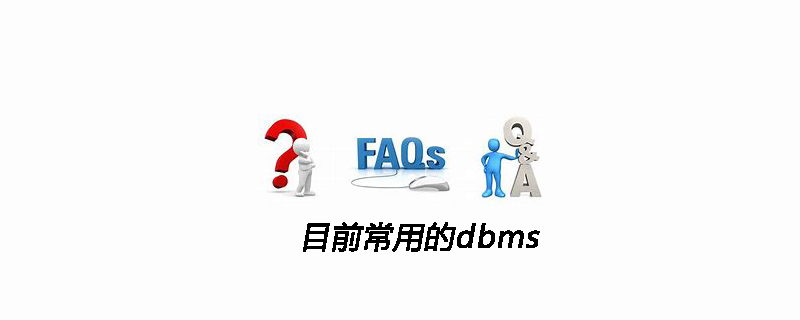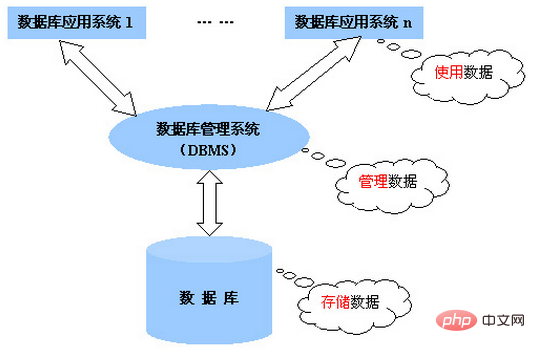Currently commonly used dbms

The common database management software (DBMS) currently on the Internet are:
1. Oracle
Oracle Database, and Named Oracle RDBMS, or Oracle for short. It is a relational database management system of Oracle Company. Its main features are:
1. Fast processing speed, very fast.
2. High security level. Supports flash and perfect recovery. Even if the hardware is broken, it can be restored to one second before the failure.
3. Several databases are used as load databases, and failover can be achieved within 30 seconds.
4, grid control, and data warehouse are also very powerful.
2. MySQL
MySQL is a small relational database management system. MySQL is widely used in small and medium-sized websites on the Internet. Its characteristics are:
1. Open source;
2. Highly non-procedural;
3. Collection-oriented operation mode;
4. With a grammatical structure Provides a variety of usage methods;
5. The language is concise, easy to learn and use.
Related recommendations: "FAQ"
3. ACCESS
The ACCESS database is a database released by Microsoft Research Management software, the full name of ACCESS is Microsoft Office Access, which is a relatively representative database management software from Microsoft. Its advantages are:
1. Single storage method, convenient for user operation and management.
2. Friendly interface and easy to operate. Access is a visual tool with the same style as Windows. If users want to generate objects and apply them, they only need to use the mouse to drag and drop, which is very intuitive and convenient.
3. Integrate the environment and process a variety of data information.
4. Access supports ODBC.
4. MS SQL Server
SQLserver database is an RMDBS database released by Microsoft Corporation of the United States, which is a relational database system. The advantages of SQLserver are:
1. True client-server architecture.
2. Graphical user interface, more intuitive and simple.
3. Rich programming interface tools provide users with more choices for programming.
4. SQLserver and Windows NT are integrated, and you can take advantage of more functions of NT.
5. It has good scalability and can run across borders. Available in multiple units from laptops to large processors.
6. Support for web technology allows users to easily publish data in the database to the web.
Extension of knowledge points:
DBMS is a database management system. A database management system is a large-scale software that manipulates and manages databases and is used to establish, use and maintain databases. , referred to as DBMS. It provides unified management and control of the database to ensure the security and integrity of the database. Users access data in the database through DBMS, and database administrators also perform database maintenance through DBMS. It enables multiple applications and users to use different methods to create, modify and query the database at the same time or at different times. Most DBMS provide data definition language DDL and data operation language DML for users to define the schema structure and permission constraints of the database and implement operations such as appending and deleting data.

The above is the detailed content of Currently commonly used dbms. For more information, please follow other related articles on the PHP Chinese website!

Hot AI Tools

Undresser.AI Undress
AI-powered app for creating realistic nude photos

AI Clothes Remover
Online AI tool for removing clothes from photos.

Undress AI Tool
Undress images for free

Clothoff.io
AI clothes remover

AI Hentai Generator
Generate AI Hentai for free.

Hot Article

Hot Tools

Notepad++7.3.1
Easy-to-use and free code editor

SublimeText3 Chinese version
Chinese version, very easy to use

Zend Studio 13.0.1
Powerful PHP integrated development environment

Dreamweaver CS6
Visual web development tools

SublimeText3 Mac version
God-level code editing software (SublimeText3)

Hot Topics
 1377
1377
 52
52
 Why Use MySQL? Benefits and Advantages
Apr 12, 2025 am 12:17 AM
Why Use MySQL? Benefits and Advantages
Apr 12, 2025 am 12:17 AM
MySQL is chosen for its performance, reliability, ease of use, and community support. 1.MySQL provides efficient data storage and retrieval functions, supporting multiple data types and advanced query operations. 2. Adopt client-server architecture and multiple storage engines to support transaction and query optimization. 3. Easy to use, supports a variety of operating systems and programming languages. 4. Have strong community support and provide rich resources and solutions.
 MySQL: An Introduction to the World's Most Popular Database
Apr 12, 2025 am 12:18 AM
MySQL: An Introduction to the World's Most Popular Database
Apr 12, 2025 am 12:18 AM
MySQL is an open source relational database management system, mainly used to store and retrieve data quickly and reliably. Its working principle includes client requests, query resolution, execution of queries and return results. Examples of usage include creating tables, inserting and querying data, and advanced features such as JOIN operations. Common errors involve SQL syntax, data types, and permissions, and optimization suggestions include the use of indexes, optimized queries, and partitioning of tables.
 What to do if the oracle can't be opened
Apr 11, 2025 pm 10:06 PM
What to do if the oracle can't be opened
Apr 11, 2025 pm 10:06 PM
Solutions to Oracle cannot be opened include: 1. Start the database service; 2. Start the listener; 3. Check port conflicts; 4. Set environment variables correctly; 5. Make sure the firewall or antivirus software does not block the connection; 6. Check whether the server is closed; 7. Use RMAN to recover corrupt files; 8. Check whether the TNS service name is correct; 9. Check network connection; 10. Reinstall Oracle software.
 How to solve garbled code in oracle
Apr 11, 2025 pm 10:09 PM
How to solve garbled code in oracle
Apr 11, 2025 pm 10:09 PM
Oracle garbled problems can be solved by checking the database character set to ensure they match the data. Set the client character set to match the database. Convert data or modify column character sets to match database character sets. Use Unicode character sets and avoid multibyte character sets. Check that the language settings of the database and client are correct.
 MySQL's Place: Databases and Programming
Apr 13, 2025 am 12:18 AM
MySQL's Place: Databases and Programming
Apr 13, 2025 am 12:18 AM
MySQL's position in databases and programming is very important. It is an open source relational database management system that is widely used in various application scenarios. 1) MySQL provides efficient data storage, organization and retrieval functions, supporting Web, mobile and enterprise-level systems. 2) It uses a client-server architecture, supports multiple storage engines and index optimization. 3) Basic usages include creating tables and inserting data, and advanced usages involve multi-table JOINs and complex queries. 4) Frequently asked questions such as SQL syntax errors and performance issues can be debugged through the EXPLAIN command and slow query log. 5) Performance optimization methods include rational use of indexes, optimized query and use of caches. Best practices include using transactions and PreparedStatemen
 How to open a database in oracle
Apr 11, 2025 pm 10:51 PM
How to open a database in oracle
Apr 11, 2025 pm 10:51 PM
The steps to open an Oracle database are as follows: Open the Oracle database client and connect to the database server: connect username/password@servername Use the SQLPLUS command to open the database: SQLPLUS
 How to read the oracle awr report
Apr 11, 2025 pm 09:45 PM
How to read the oracle awr report
Apr 11, 2025 pm 09:45 PM
An AWR report is a report that displays database performance and activity snapshots. The interpretation steps include: identifying the date and time of the activity snapshot. View an overview of activities and resource consumption. Analyze session activities to find session types, resource consumption, and waiting events. Find potential performance bottlenecks such as slow SQL statements, resource contention, and I/O issues. View waiting events, identify and resolve them for performance. Analyze latch and memory usage patterns to identify memory issues that are causing performance issues.
 How to change the oracle table name
Apr 11, 2025 pm 11:54 PM
How to change the oracle table name
Apr 11, 2025 pm 11:54 PM
Two ways to rename Oracle table names: use SQL statements: ALTER TABLE <Old table name> RENAME TO <New table name>;Use PL/SQL statements: EXECUTE IMMEDIATE 'ALTER TABLE ' || :old_table_name || ' RENAME TO ' || :new_table_name;



